NCERT Exemplar Class 11 Physics Chapter 10 Thermal Properties of Matter are part of NCERT Exemplar Class 11 Physics . Here we have given NCERT Exemplar Class 11 Physics Chapter 10 Thermal Properties of Matter.
NCERT Exemplar Class 11 Physics Chapter 10 Thermal Properties of Matter
Q1. A bimetallic strip is made of aluminium and steel (aAI > astee|) On heating, the strip will
(a) remain straight (bj get twisted
(c) will bend with aluminium on concave side.
(d) will bend with steel on concave side
Sol:
(d)
Key concept:
Bi-metallic strip-. Two strips of equal lengths but of different materials (different coefficient of linear expansion) when join together, it is called “bi-metallic strip”, and can be used in thermostat to break or make electrical contact. This strip has the characteristic property of bending on heating due to unequal linear expansion of the two metal. The strip will bend with metal of greater a on outer side, i.e. convex side.
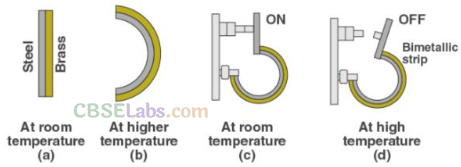
On heating, the metallic strip with higher coefficient of linear expansion (∝
A
l
) will expand more.
According to the question, ∝
AI
> ∝
steel
, so aluminum will expand more. So, it should have larger radius of curvature. Hence, aluminium will be on convex side. The metal of smaller ∝ (i.e., steel) bends on inner side, i.e., concave side.
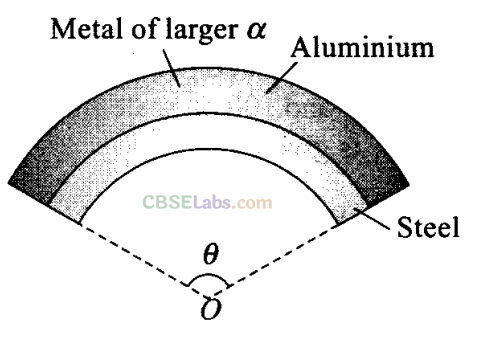
Q2. A uniform metallic rod rotates about its perpendicular bisector with constant angular speed. If it is heated uniformly to raise its temperature slightly
(a) its speed of rotation increases
(b) its speed of rotation decreases
(c) its speed of rotation remains same
(d) its speed increases because its moment of inertia increases
Sol:
(b) When the rod is heated uniformly to raise its temperature slightly, it expands. So, moment of inertia of the rod will increase.
Moment of inertia of a uniform rod about its perpendicular bisector
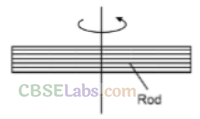
If the temperature increases, moment of inertia will increase.
No external torque is acting on the system, so angular momentum should be conserved.
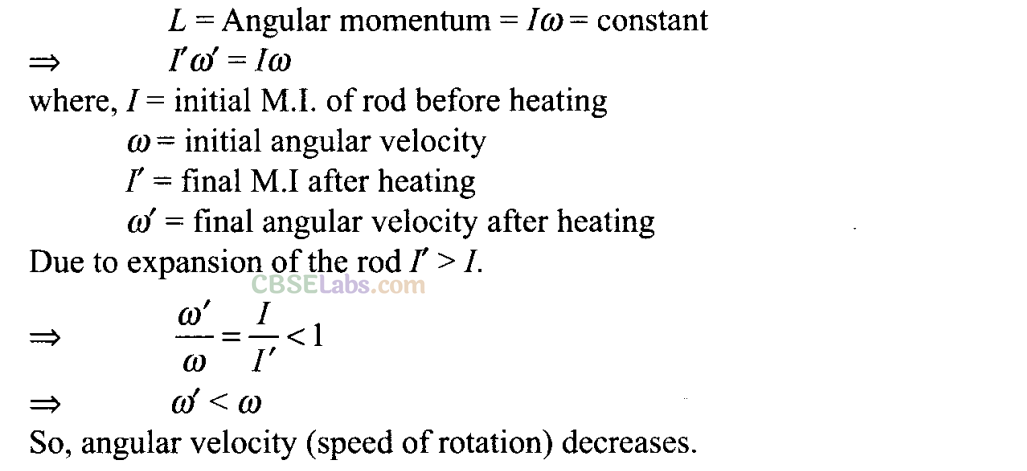
Q3. The graph between two temperature scales A and B is shown in figure between upper fixed point and lower fixed point there are 150 equal division on scale A and 100 on scale B. The relationship for conversion between the two scales is given by
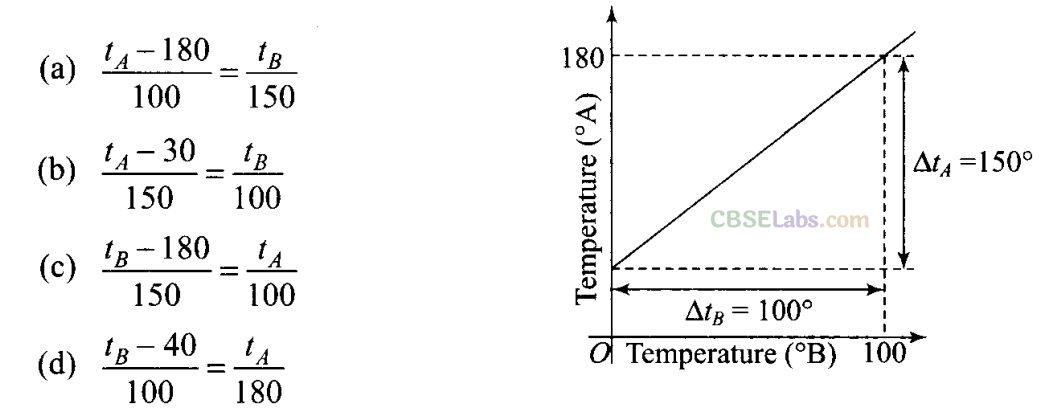
Sol: Key concept:
Temperature on one scale can be converted into other scale by using the following identity.
Reading on any scale – LFP /UFP – LFP = Constant for all scales
where, LFP —> Lower fixed point
UFP —>Upper fixed point
From the graph it is clear that the lowest point for scale A is 30° and highest point for the scale A is 180°.
Lowest point for scale B is 0° and highest point for scale B is 100°. Hence, the relation between the two scales A and B is given by
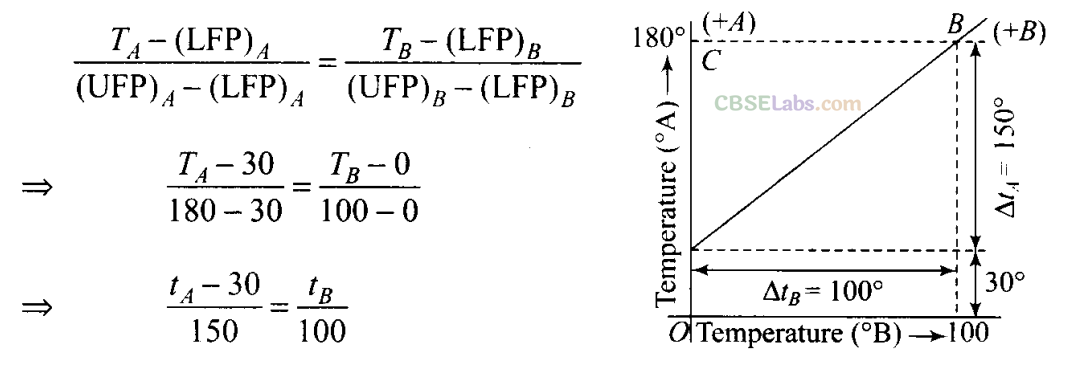
Q4. An aluminium sphere is dipped into water.
Which of the following is true?
(a) Buoyancy will be less in water at 0°C than that in water at 4°C.
(b) Buoyancy will be more in water at 0°C than that in water at 4°C.
(c) Buoyancy in water at 0°C will be same as that in water at 4°C.
(d) Buoyancy may be more or less in water at 4°C depending on the radius of the sphere.
Sol:
(a)
Key concept: Liquids generally increase in volume with increasing temperature but in case of water, it expands on heating if its temperature is greater than 4°C. The density of water reaches a maximum value of 1.000 g/cm3 at 4°C.
This behaviour of water in the range from 0°C to 4°C is called anomalous expansion.
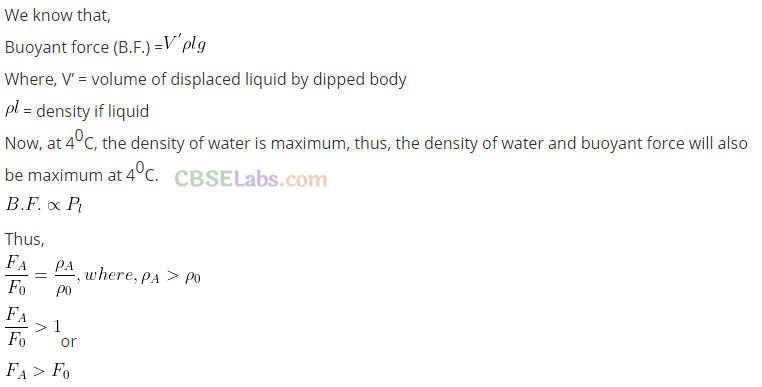
Q5. As the temperature is increased, the period of a pendulum
(a) increases as its effective length increases even though its centre of mass still remains at the centre of the bob
(b) decreases as its effective length increases even though its centre of mass ‘ still remains at the centre of the bob
(c) increases as its effective length increases due to shifting to centre of mass below the centre of the bob
(d) decreases as its effective length remains same but the centre of mass shifts above the centre of the bob
Sol:
(a) A pendulum clock keeps proper time at temperature θ
0
. If temperature is increased to θ (>θ
0
), then due to linear expansion, length of pendulum increases and hence its time period will increase
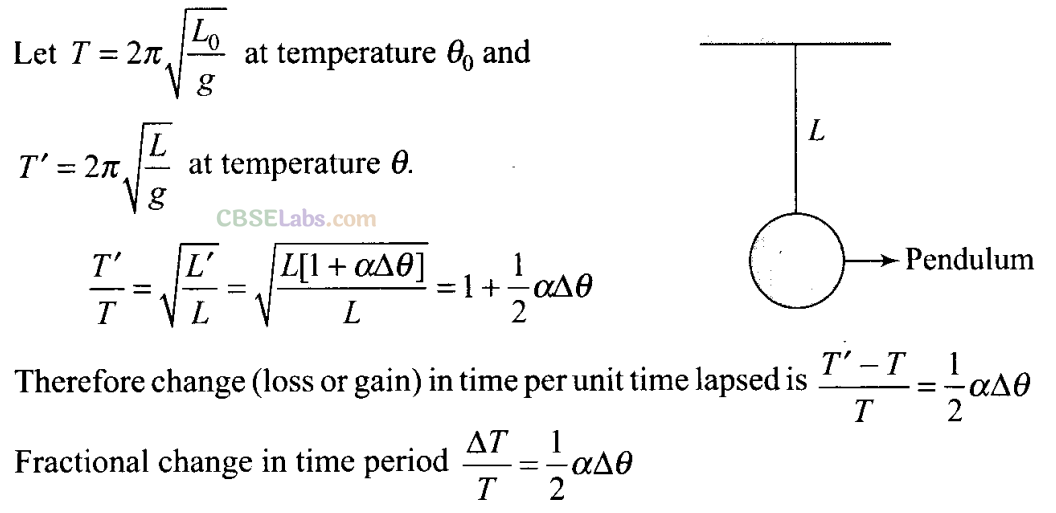
So, as the temperature increases, length of pendulum increases and hence time period of pendulum increases. Due to increment in its time period, a pendulum clock becomes slow in summer and will lose time.
Q6. Heat is associated with
(a) kinetic energy of random motion of molecules
(b) kinetic energy of orderly motion of molecules
(c) total kinetic energy of random and orderly motion of molecules
(d) kinetic energy of random motion in some cases and kinetic energy of orderly motion in other
Sol:
(a) When a body is heated its temperature rises and in liquids and gases vibration of molecules about their mean position increases, hence kinetic energy associated with random motion of molecules increases.
So, thermal energy or heat associated with the random and translatory motions of molecules.
Q7. The radius of a metal sphere at room temperature Tis Rand the coefficient of linear expansion of the metal is .The sphere heated a little by a temperature ∆Tso that its new temperature is T + ∆T.The increase in the volume of the sphere is approximately.
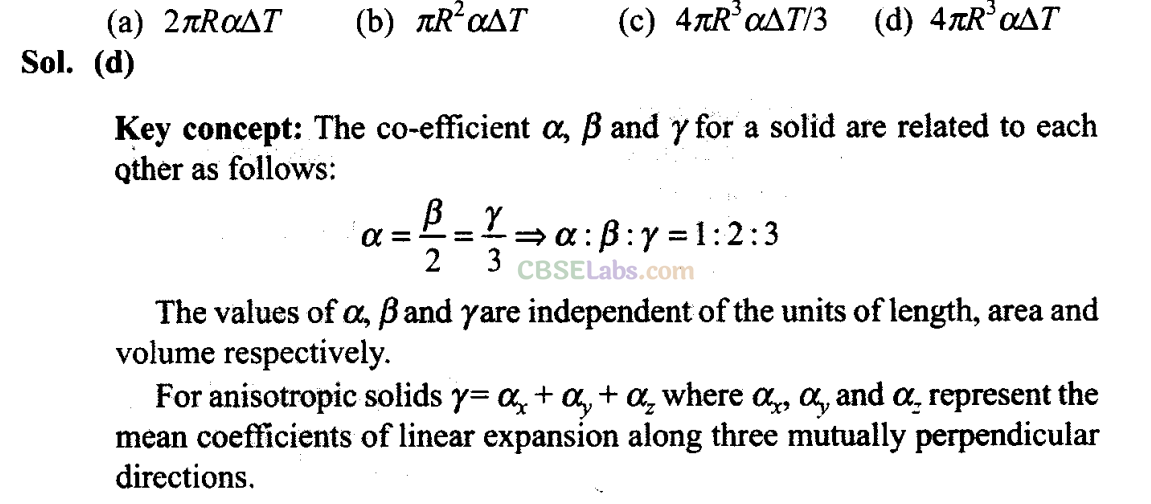
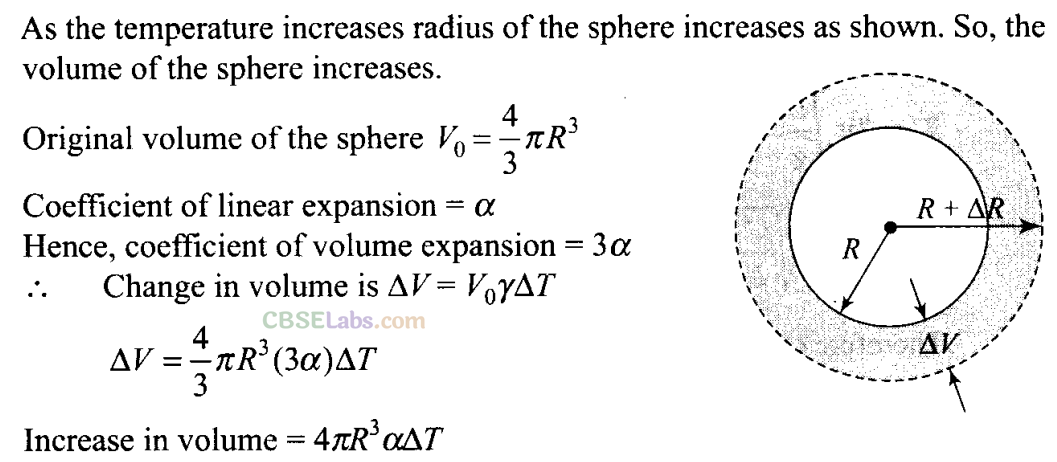
ρ = mass / volume
So, the volume of all object will also be same.
Here the cooling will be done in the form of radiations that is according to Stefan’s law. Since, emissive power is directly proportional to the surface. Here, for given volume, sphere has least surface area and circular plate of greatest surface area.
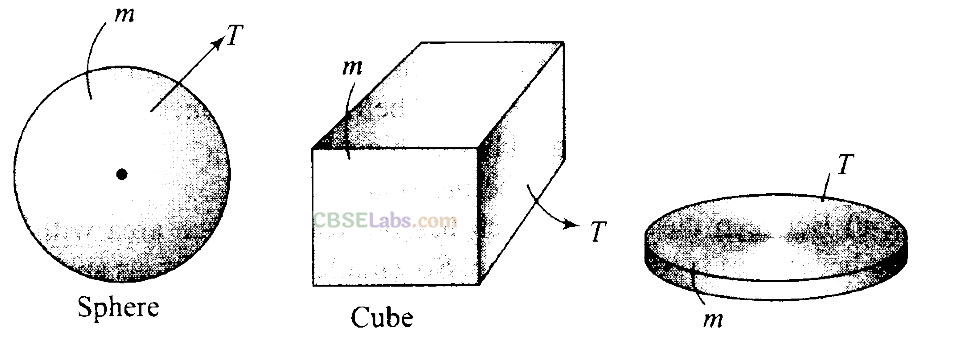
As thickness of the plate is least, hence surface area of the plate is maximum. According to Stefan’s law, heat loss (cooling) is directly proportional to the surface area.
H
sphere
: H
cube
: H
plate
= A
sphere
: A
cube
: A
plate
As A
plate
is maximum, hence the plate will cool fastest.
As the sphere is having minimum surface area, hence the sphere cools slowest.
More Than One Correct Answer Type
Q9. Mark the correct options.
(a) A system X is in thermal equilibrium with Y but not with Z. The systems Y and Z may be in thermal equilibrium with each other.
(b) A system X is in thermal equilibrium with Y but not with Z. The systems Y and Z are not in thermal equilibrium with each other.
(c) A system X is neither in thermal equilibrium with Y nor with Z. The systems Y and Z must be in thermal equilibrium with each other.
(d) A system X is neither in thermal equilibrium with Y nor with Z. The systems Y-and Z may be in thermal equilibrium with each other.
Sol: (b, d)
Key concept:
Two bodies are said to be in thermal equilibrium with each other
,
when no heat flows from one body to the other. That is when both the bodies are at the same temperature.
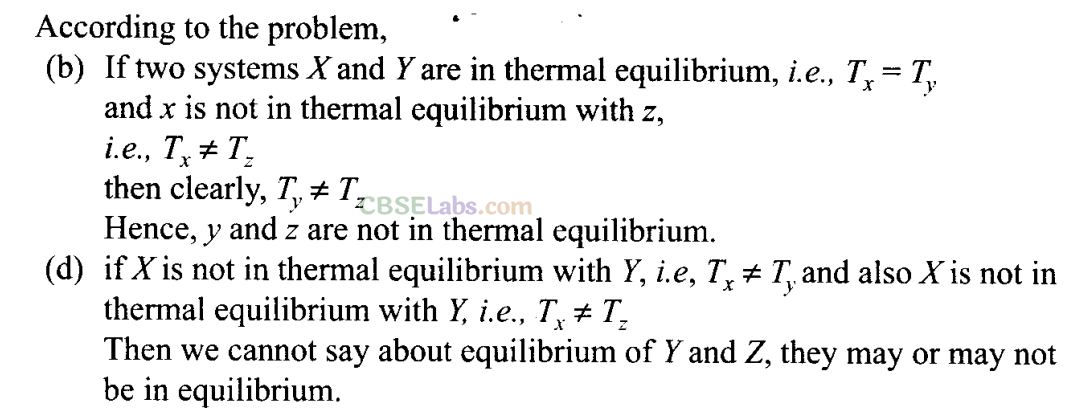
Q10. Gulab jamuns (assumed to be spherical) are to be heated in an oven. They are available in two sizes, one twice bigger (in radius) than the other. Pizzas (assumed to be discs) are also to be heated in oven. They are also in two sizes, one twice bigger (in radius) than the other. All four are put together to be heated to oven temperature. Choose the correct option from the following.
(a) Both size gulab jamuns will get heated in the same time
(b) Smaller gulab jamuns are heated before bigger ones
(c) Smaller pizzas are heated before bigger ones
(d) Bigger pizzas are heated before smaller
Sol:
(b, c) Between these four which has the least surface area will be heated first because of less heat radiation. So, smaller gulab jamuns are having least surface area, hence they will be heated first.
Similarly, smaller pizzas are heated before bigger ones because they are of small surface areas.
Q11. Refer to the plot of temperature versus time (figure) showing the changes in the state if ice on heating (not to scale). Which of the following is correct?
(a) The region AB represents ice and water in thermal equilibrium
(b) At B water starts boiling
(c) At C all the water gets converted into steam
(d) C to D represents water and steam in equilibrium at boiling point
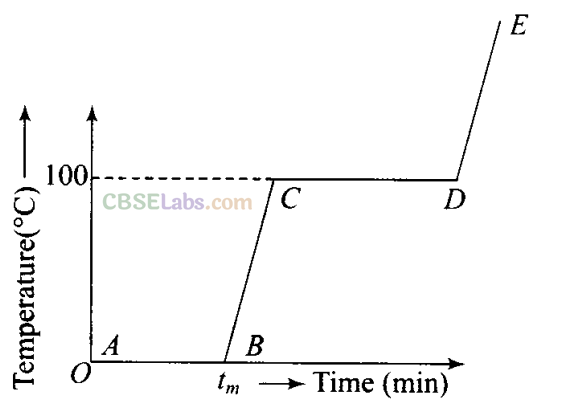
Sol:
(a, d) During phase change process, temperature of the system remains constant.
(a) In region AB, a phase change takes place, heat is supplied and ice melts but temperature of the system is 0°C. it remains constant during process. The heat supplied is used to break bonding between molecules.
(b) In region CD, again a phase change takes place from a liquid to a vapour state during which temperature remains constant. It shows water and steam are in equilibrium at boiling point.
Q12. A glass full of hot milk is poured on the table. It begins to cool gradually. Which of the following is correct?
(a) The rate of cooling is constant till milk attains the temperature of the surrounding.
(b) The temperature of milk falls off exponentially with time.
(c) While cooling, there is a flow of heat from milk to the surrounding as well as from surrounding to the milk but the net flow of heat is from milk to the surrounding and that is why it cools.
(d) All three phenomenon, conduction, convection and radiation are responsible for the loss of heat from milk to the surroundings.
Sol:
(b, c, d) When hot milk spread on the table heat is transferred to the surroundings by conduction, convection and radiation. Because the surface area of poured milk on a table is more than the surface area of milk filled in a glass. Hence, its temperature falls off exponentially according to Newton’s law of cooling. Heat also will be transferred from surroundings to the milk but will be lesser than that of transferred from milk to the surroundings. So, option (b), (c) and (d) are correct.
Very Short Answer Type Questions
Q13. Is the bulb of a thermometer made of
diathermic
or adiabatic wall?
Sol:
The bulb of a thermometer is made up of diathermic wall because diathermic walls allow exchange of heat energy between two systems but adiabatic walls do not. So it receives heat from the body to measure the temperature of body.
Q14. A student records the initial length
l ,
change in temperature ∆ T and change in length ∆ l of a rod as follows:
| S. No | l(m) | ∆T(°C) | ∆l(m) |
| 1. | 2 | 10 | 4 x 10 -4 |
| 2. | 1 | 10 | 4 x 10 -4 |
| 3. | 2 | 20 | 2 x 10 -4 |
| 4. | 3 | 10 | 6x 10 -4 |
If the first observation is correct, what can you say about observations 2, 3 and 4.
Sol:
If the first observation is correct, hence from the 1st observation we get the coefficient of linear expansion
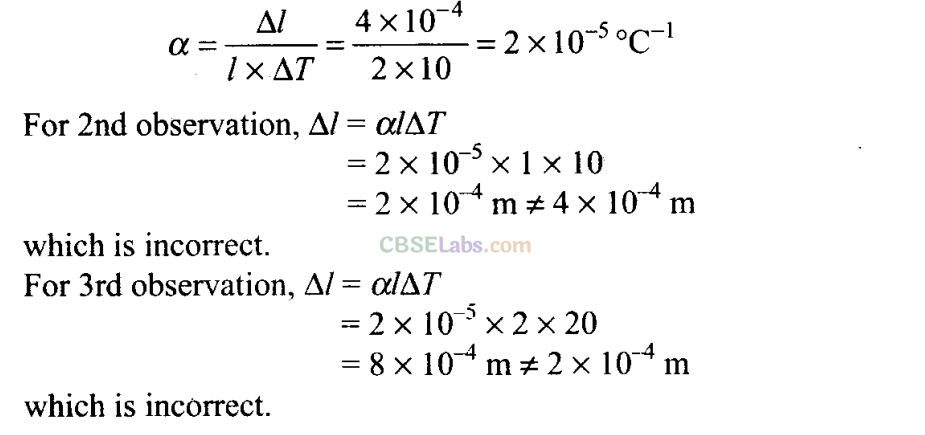
For 4th observation, ∆l = ∝l∆T
= 2 x 10
-5
x 3 x 10 = 6 x 10
-4
m [i.e., observed value is correct]
Q15. Why does a metal bar appear hotter than a wooden bar at the same temperature? Equivalently it also appears cooler than wooden bar if they are both colder than room temperature.

Now since (E
λ
)
Black
is constant at a given temperature, according to this law if a surface is a good absorber of a particular wavelength it is also a good emitter of that wavelength.
This in turn implies that a good absorber is a good emitter (or radiator).
The conductivities of metals are very high compared to wood. Due to difference in conductivity, if one touch the hot metal with a finger, heat from the surrounding flows faster to the finger from metals and so one feels the heat.
Similarly, when one touches a cold metal the heat from the finger flows away to the surroundings faster. So we can say that a good radiator can be a good absorber.
Q16. Calculate the temperature which has numeral value on Celsius and Fahrenheit scale.
Sol:
To construct a scale of temperature, two fixed points are taken. First fixed point is the freezing point of water, it is called lower fixed point. The second fixed point is the boiling point of water, it is called upper fixed point. Temperature on one scale can be converted into other scale by using the following identity.


Q17. These days people use steel utensils with copper bottom. This is supposed to be good for uniform heating of food. Explain this effect using the fact that copper is the better conductor. Junction
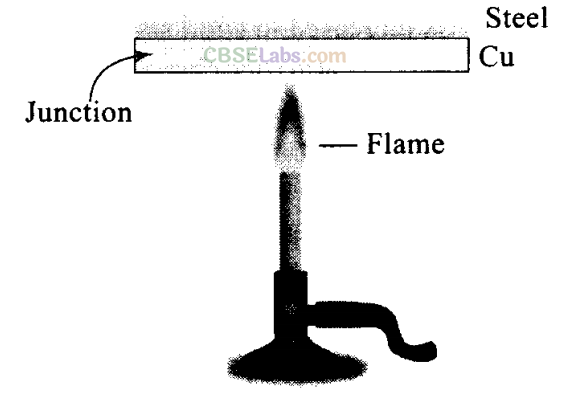
Sol:
The copper bottom of the steel utensil gets heated quickly.
Because of the reason that copper is a good conductor of heat as compared to steel. But steel does not conduct as quickly, thereby allowing food inside to get heated uniformly.
Short Answer Type Questions
Q18. Find out the increase in moment of inertia I of a uniform rod (coefficient of linear expansion a) about its perpendicular bisector when its temperature is slightly increased by ∆T.
Sol:
Moment of inertia of a uniform rod of mass M and length l about its perpendicular bisector

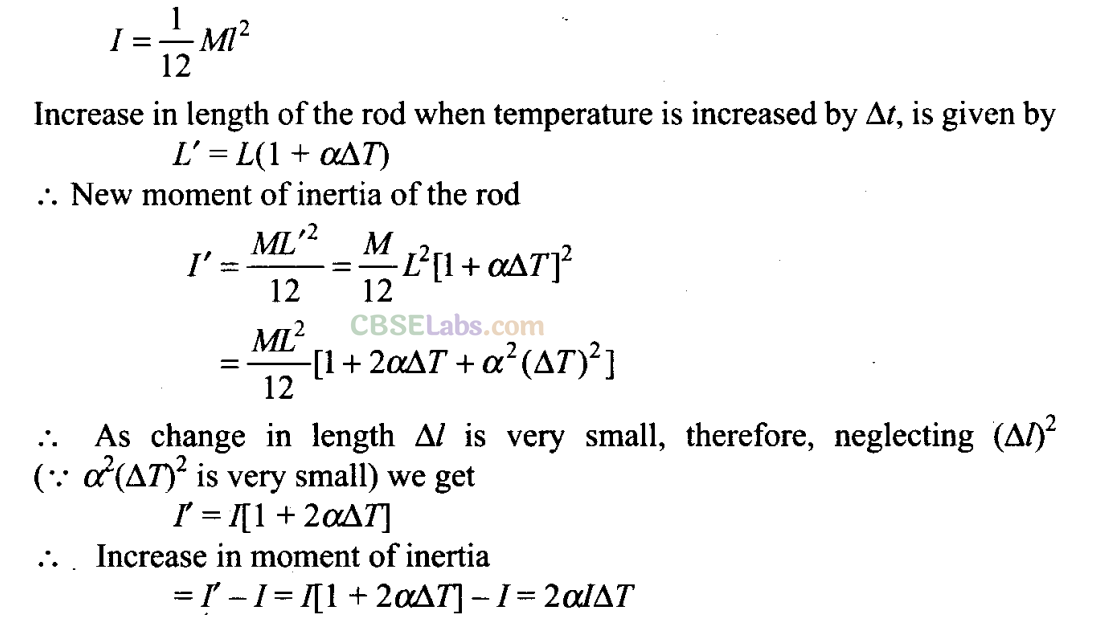
Q19. During summers in India, one Of the common practice to keep cool is to make ice balls of crushed ice, dip it in flavored sugar syrup and sip it. For this a stick is inserted into crushed ice and is squeezed in the palm to make it into the ball. Equivalently in winter in those areas where it snows, people make snow balls and throw around. Explain the formation of
ball
out of crushed ice or snow in the light of p-T diagram of water.
Sol : Given diagram shows the variation of pressure with temperature for water. When the pressure is increased in solid state (at 0°, 1 atm), ice changes into liquid state while decreasing pressure in liquid state (at 0°, 1 atm), water changes to ice.
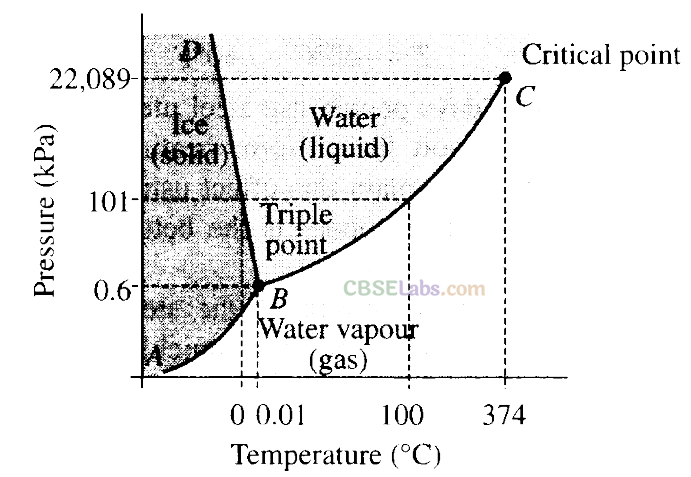
When crushed ice is squeezed, some of it melts, filling up the gap between ice flakes upon releasing pressure. This water freezes, binding all ice flakes and making the ball more stable.
Q20. 100 g of water is super cooled to -10°C. At this point, due to some disturbance mechanised or otherwise some of it suddenly freezes to ice. What will be the temperature of the resultant mixture and how much mass would freeze?
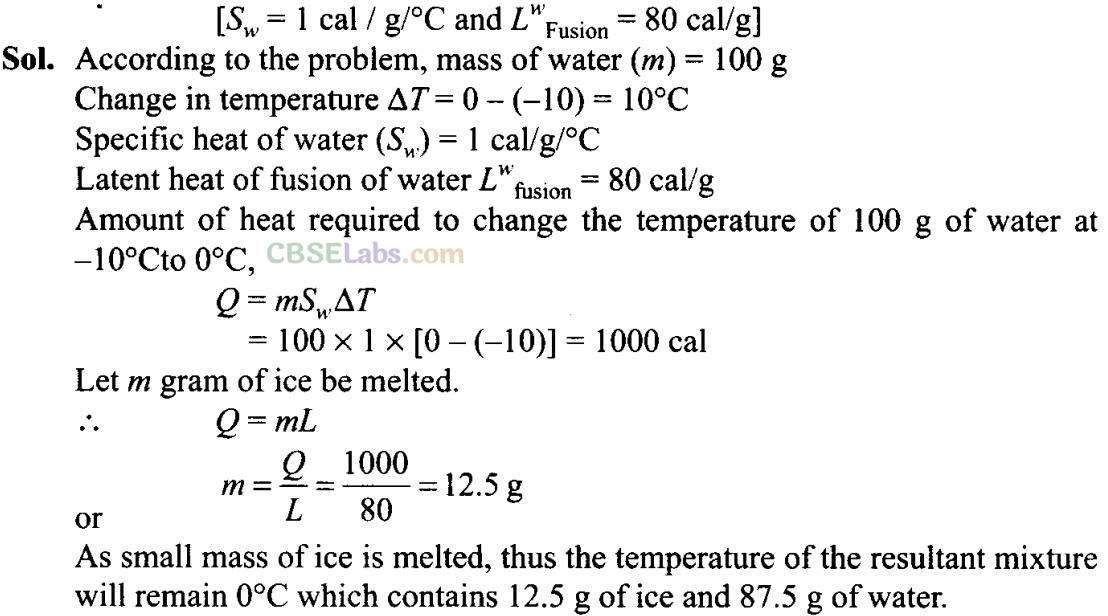
Q21. One day in the morning Ramesh filled up 1/3 bucket of hot water from geyser, to take bath. Remaining 2/3 was to be filled by cold water (at room temperature) to bring mixture to a comfortable temperature. Suddenly Ramesh had to attend to something which would take some times, say 5-10 min before he could take bath. Now, he had two options (i) fill the remaining bucket completely by cold water and then attend to the work, (ii) first attend to the work and fill the remaining bucket just before taking bath. Which option do you think would have kept water warmer? Explain
Sol:
According to the Newton’s law o‘f cooling, the rate of loss of heat is directly proportional to the difference of temperature. Or we can say which gives a consequence about rate of fall of temperature of a body with respect to the difference of temperature of body and surroundings.
The first option would have kept water warmer because by adding hot water to cold water, the temperature of the mixture decreases. Due to this temperature difference between the mixed water in the bucket and the surrounding decreases, thereby the decrease in the rate of loss of the heat by the water.
In second option, the hot water in the bucket will lose heat quickly. So if he first attend to the work and fill the remaining bucket with cold water which already lose much heat in 5-10 minutes then the water become more colder as comparison with first case.
Long Answer Type Questions
Q22. We would like to prepare a scale whose length does not change with temperature. It is proposed to prepare a unit scale of this type whose length remains, say 10 cm. We can use a bimetallic strip made of brass and iron each of different length whose length (both components) would change in such a way that difference between their length B remain constant. If α
iron
= 1.2 x 10
-5
/K and α
brass
= 1.8xl0
-5
/K, what should we take as
length
of each strip?
Sol: According to the problem, L
1
-L
b
= 10 cm where,
L
1
= length of iron scale
L
b
= Length of brass scale
This condition is possible if change in length both the rods is remain same at all temperatures.
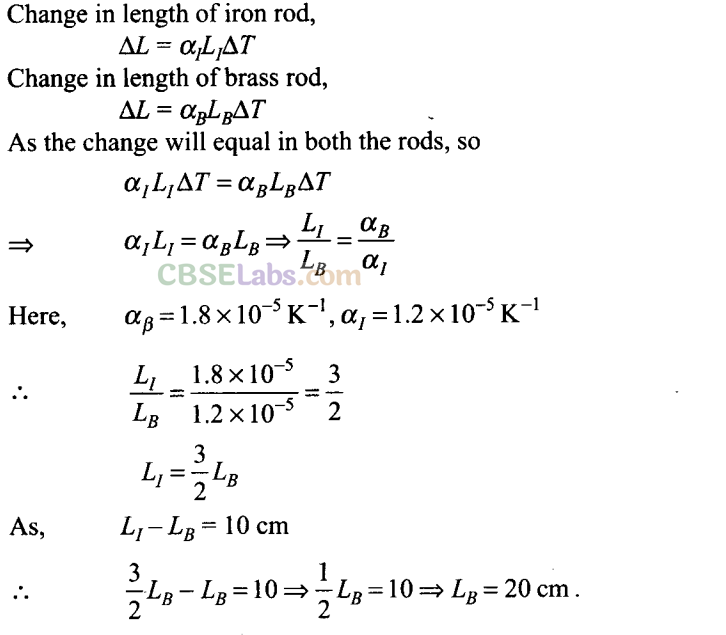
Q23. We would like to make a vessel whose volume does not change with temperature (take a hint from the problem above). We can use brass and iron (β
vbrass
=
6 x 10
5
/ K and β
viron
= 3.55 x 10
-5
/K) to create a volume of 100 cc. How do you think you can achieve this?
Sol:
Here we are making a vessel whose Brass volume does not change with temperature.
To make the desired vessel, we should have an iron vessel with a brass rod inside as shown in the diagram.
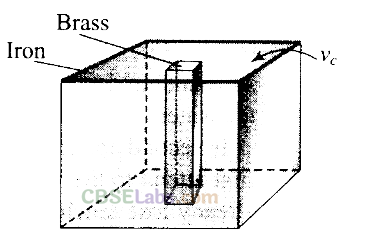
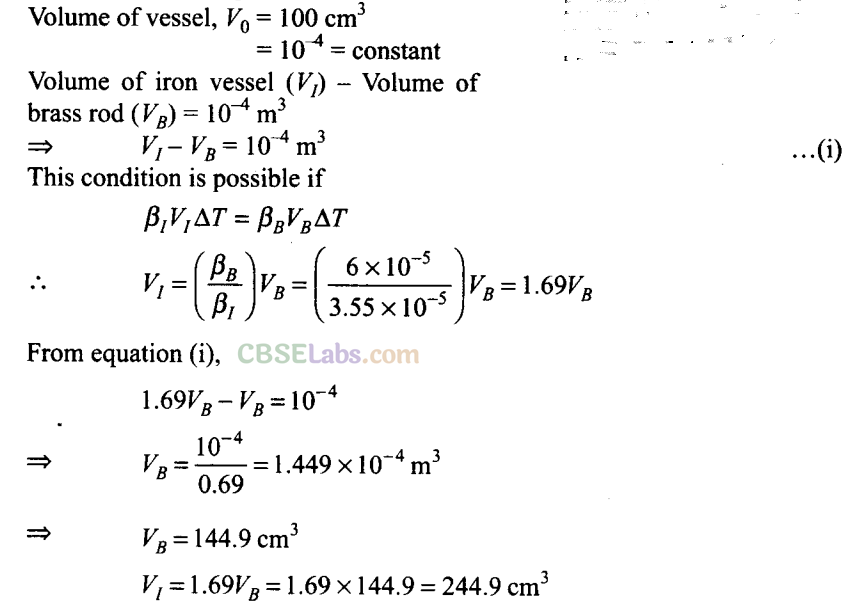
Therefore, an iron vessel with a volume of 249.9 cm
3
fitted with a brass rod of volume 144.9 cm
3
will serve as a vessel of volume 100 cm
3
, which will not change with temperature.
Important points:
- Solids can expand in one dimension (linear expansion), two dimensions (superficial expansion) and three dimensions (volume expansion) while liquids and gases usually suffers change in volume only.
- Thermal expansion is minimum in case of solids but maximum in case of gases because intermoleeular force is maximum in solids but minimum in gases.
Q24 . Calculate the stress developed inside a tooth cavity filled with copper when hot tea at temperature of 57°C is drunk. You can take body (tooth) temperature to be 37°C and a = 1.7x 10 -5 /°C bulk modulus for copper = 140x 10 9 N/m 2 .
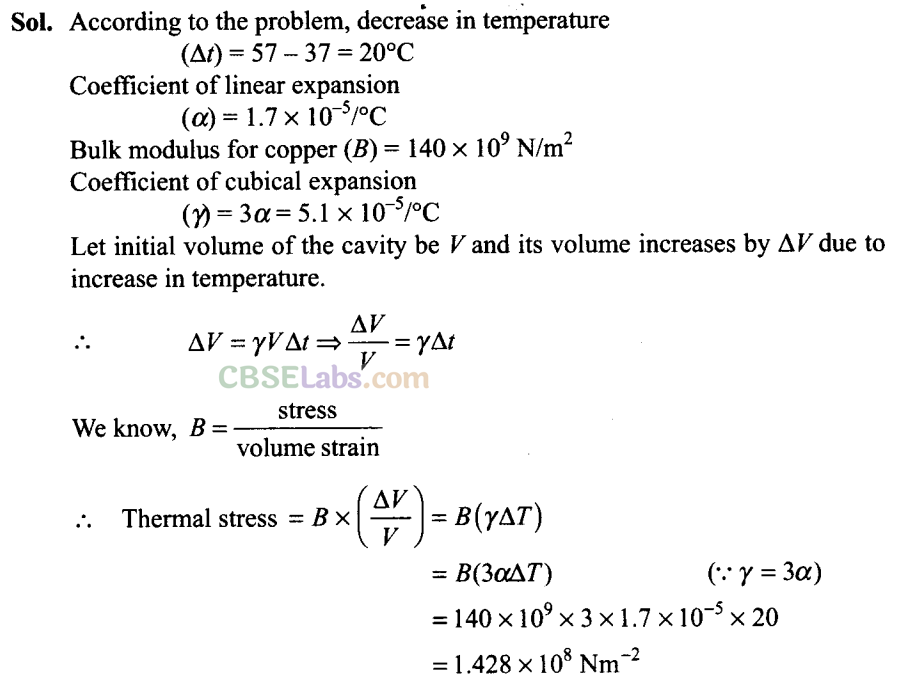
This is about 10
3
times of atmospheric pressure
Q25. A rail track made of steel having length 10 m is clamped on a railway line at its two ends (figure). On a summer day due to rise in temperature by 20°C. It is deformed as shown in figure. Find x (displacement of the centre) if27
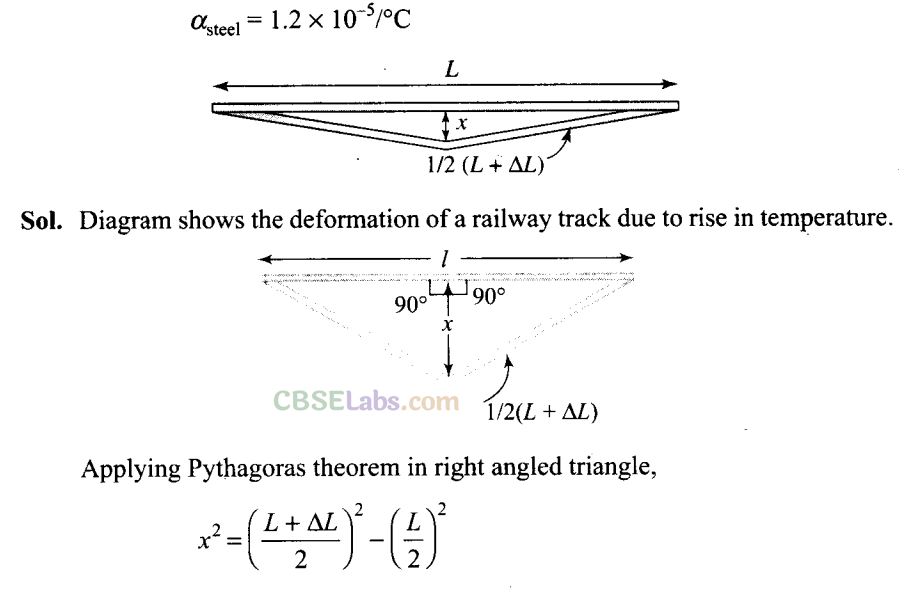
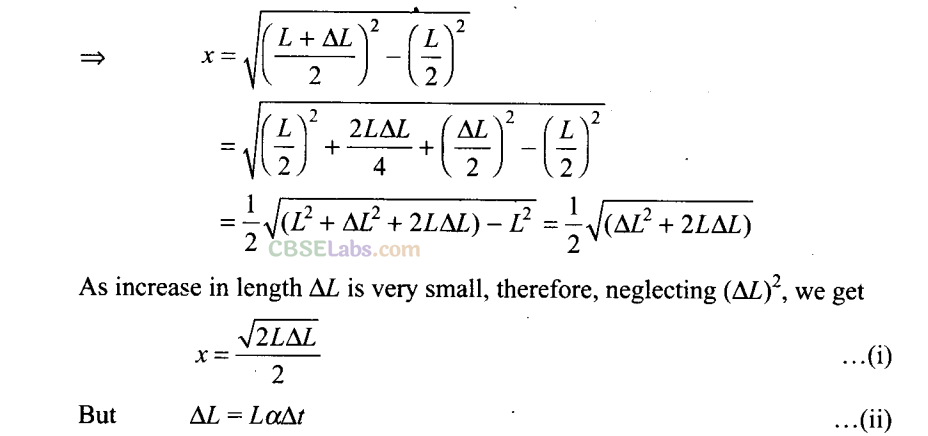
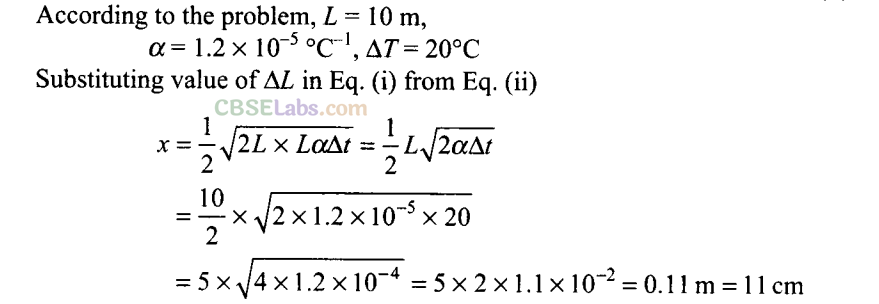
Q26. A thin rod. having length L
0
at 0°C and coefficient of linear expansion α has its two ends maintained at temperatures θ
1
, and θ
2
, Find its new length.
Sol.
When temperature of a rod varies linearly, then average temperature of the middle point of the rod can be taken as mean of temperatures at the two ends. According to the diagram,
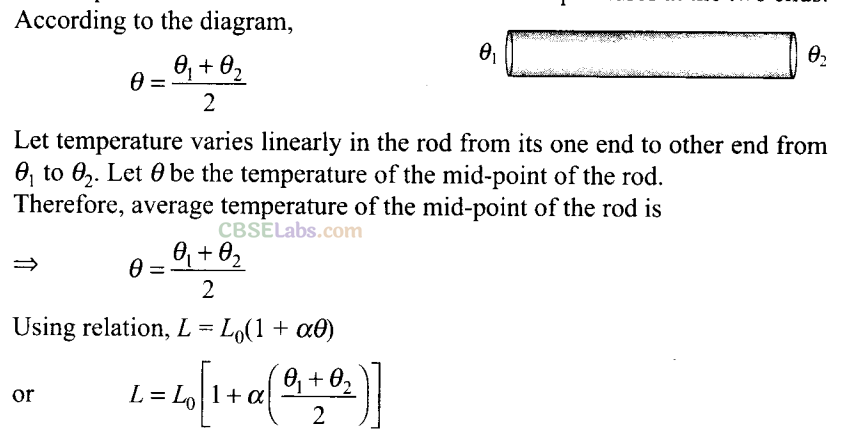
NCERT Exemplar Class 11 Physics Solutions
- Chapter 1 Units and Measurements
- Chapter 2 Motion in a Straight Line
- Chapter 3 Motion in a Plane
- Chapter 4 Laws of Motion
- Chapter 5 Work, Energy and Power
- Chapter 6 System of Particles and Rotational Motion
- Chapter 7 Gravitation
- Chapter 8 Mechanical Properties of Solids
- Chapter 9 Mechanical Properties of Fluids
- Chapter 10 Thermal Properties of Matter
- Chapter 11 Thermodynamics
- Chapter 12 Kinetic Theory
- Chapter 13 Oscillations
- Chapter 14 Waves